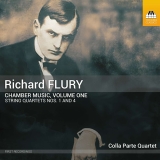Johannes Brahms und Anton Bruckner waren u.a. seine musikalischen Wegweiser, schreibt der Schweizer Komponist Richard Flury in seinen Erinnerungen. Die Spuren beider Spätromantiker sind in den Quartetten Nummer eins und vier nicht zu überhören.
Das erste Quartett aus dem Jahre 1926 atmet in der Lesart des Colla Parte Quartett klassischen Esprit, der das Innenleben des Werkes auf fein poetische Manier offenlegt. Obwohl kompakt, bleibt der Klang stets transparent und gibt derart Einblick in die leicht melancholische, nostalgische Welt der Spätromantik.
Einfühlsam und geradezu betörend erklingt das Andante, dessen weiten Spannungsbogen die Interpreten mit großer darstellerischer Kraft entstehen lassen. Es folgen ein vitales, fein verspieltes Menuett und ein schwungvoller, leichtfüßiger Rondo-Schlusssatz – inhaltlich ein gelungener Kontrast zu den beiden ersten Sätzen.
Bei einer Blindverkostung hätte man das vierte Streichquartett aufgrund seines Einstiegs zunächst Anton Bruckner zugeordnet. Aber auch hier findet Richard Flury rasch zu einer sehr persönlichen Tonsprache, in der sich der Klang zunehmend verdichtet. Ohne sich aufzudrängen, lässt das Colla Parte Quartett diese Klangdichte ganz organisch entstehen, wobei es auf gekonnte Manier das thematische Material stets neu formuliert und keine Leerstellen zulässt. Der Ton bleibt dabei schwungvoll, leicht federnd und klar trotz harmonischer Schärfen, die an der Atonalität kratzen.
Der langsame Satz – Andante – ist geprägt von inniger Schwermut in feiner Kantabilität und einer geradezu heiter anmutenden Mittelepisode. Wie blindes kammermusikalisches Verständnis klingt, unterstreicht das Colla Parte Quartett – als eines von vielen Beispielen – im fugenähnlichen Vivace-Satz: keine Stimme, keine Note, kein Akzent wird der Bedeutungslosigkeit anheim gegeben – und damit insgesamt auch die Musik von Richard Flury, die in den vier Schweizer Musikern überzeugte, kompetente und begeisterte Verfechter hat.
Johannes Brahms and Anton Bruckner, among others, were his musical guides, writes the Swiss composer Richard Flury in his memoirs. The traces of both late Romantics cannot be ignored in quartets Nos. 1 and 4.
The first quartet from 1926 breathes classical esprit in the Colla Parte Quartet’s reading, which reveals the inner life of the work in a finely poetic manner. Although compact, the sound always remains transparent and thus provides an insight into the slightly melancholy, nostalgic world of late Romanticism.
The Andante sounds sensitive and almost beguiling, with the performers creating a broad arc of tension with great dramatic power. This is followed by a lively, finely playful minuet and a lively, light-footed final rondo movement – a successful contrast to the first two movements in terms of content.
In a blind tasting, the fourth string quartet would initially have been assigned to Anton Bruckner due to its opening. But here, too, Richard Flury quickly finds a very personal tonal language in which the sound becomes increasingly dense. Without imposing itself, the Colla Parte Quartet allows this density of sound to develop organically, constantly reformulating the thematic material in a skillful manner and leaving no gaps. The tone remains lively, slightly bouncy and clear despite harmonic sharpnesses that scratch atonality.
The slow movement – Andante – is characterized by heartfelt melancholy in a subtle cantabile style and an almost cheerful middle episode. In the fugue-like Vivace movement, the Colla Parte Quartet underlines – as one of many examples – how blind understanding of chamber music sounds: no voice, no note, no accent is relegated to insignificance – and thus also the music of Richard Flury, which has convincing, competent and enthusiastic advocates in the four Swiss musicians.






















